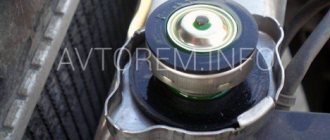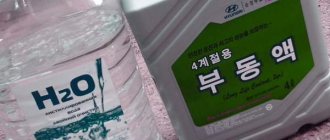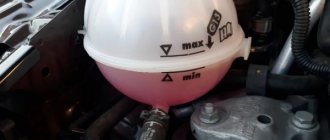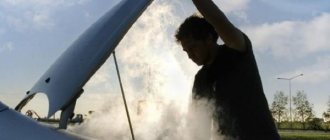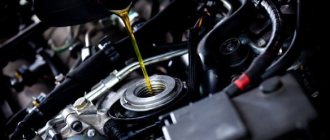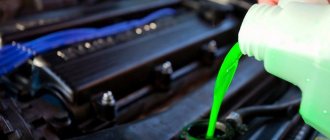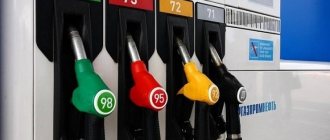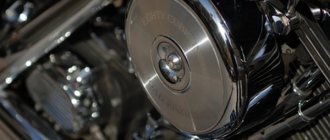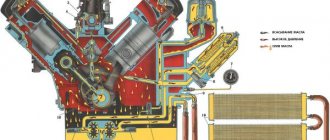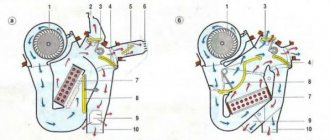Which is better, concentrate or ready-made antifreeze?
There are both ready-to-fill antifreeze and concentrates available for sale, which you need to dilute yourself with distilled water. So what is the best product to buy? Let's consider the advantages and disadvantages in this matter:
Ready-made antifreeze can be immediately poured into the car.
- independent preparation allows you to make the coolant that is needed for a certain temperature in a certain climate zone;
- The downside of the concentrate is that it must first be diluted. And for this you need to purchase a clean container and distilled water. And if you don’t have a garage, you’ll also have to worry about finding the right space. Whereas ready-made antifreeze can be immediately poured into the car.
When draining used antifreeze, you need to check its condition. If it is cloudy and contains sediment, this means that it has worked longer than expected. It is also worth closely inspecting the cooling system, and possibly making repairs.
The difference between ready-made antifreeze and concentrate
Overall, these are the same product. Their most important difference is their saturation, since ready-made antifreeze is a concentrate diluted with water.
It is believed that concentrate is an economically more profitable purchase. In turn, the finished coolant does not require wasting extra time on dilution with water, and is therefore more convenient for use. Therefore, what is better to choose - antifreeze or concentrate, each driver must decide for himself, based on personal preferences.
| GM Antifreeze red | Mobil Concentrate | Total Concentrate | CoolStream Antifreeze |
| More details | More details | More details | More details |
View the full catalog of "Antifreeze"
How to dilute antifreeze concentrate
To dilute the concentrate, you will need distilled water. Of course, you don’t have to buy it at the pharmacy. Also, you cannot take tap water or from reservoirs. But if necessary, it is possible to boil tap water for thirty minutes and cool.
By reducing the proportion of water in the concentrate, you can reduce the freezing threshold of antifreeze.
It is strictly forbidden to use undiluted concentrated antifreeze. To understand how to properly dilute antifreeze concentrate, you need to read the instructions on the bottle. But first, you need to drain the used antifreeze and rinse the system with distilled water. Then add properly diluted coolant. In summer, it is recommended to add more water. In what proportions to dilute antifreeze concentrate with water:
| Water – concentrate | Freezing threshold, °C | Boiling threshold, °C |
| 87,5% – 12,5% | -7 | +100 |
| 75% – 25% | -15 | +100 |
| 50% – 50% | from -40 to -45 | from +130 to +140 |
| 40% – 60% | -50 to -60 | from +150 to +160 |
| 25% – 75% | -70 | +170 |
Antifreeze for motorists
There are many manufacturers of coolants, both foreign and domestic. But motorists buy antifreeze according to operational requirements. Widespread brands are G 11 and G 12.
Grade G 11 is green in color and has a service life of 3 years. Brand G 12 is distinguished by its red color. And the absence of silicates in it makes it possible to operate it for up to 7 years. It is worth remembering that they do not mix with each other.
This is interesting: Chevrolet Cruze: nuances of sale
List of actions on how to dilute red antifreeze concentrate:
- drain the old fluid from the tank, radiator and cylinder block;
- rinse with distilled water. Water is poured into the system. The engine starts for a short time;
- the water is drained;
- take G 12 concentrate, water and clean containers;
- according to the table, apply a solution suitable for your climate zone;
- the solution is poured into the cooling system;
- After short-term operation, check the level. If necessary, add solution.
Well-known brands of antifreeze concentrate
There are a dozen and a half manufacturers of high-quality antifreeze concentrate
The choice of brand of antifreeze concentrate must be made taking into account the specific conditions of its use.
- Antifreeze GM dex cool longlife, concentrate. Has high anti-corrosion properties. Does not form sediment.
- Antifreeze G12, concentrate. Endurance in hard water. Favorable effect on rubber at t +100°C. Suitable for older machines, extending their service life.
- Mobil antifreeze, concentrate. High anti-corrosion properties. Used in cast iron and aluminum motors. Resistant to freezing even in extreme frosts.
- Shell antifreeze, concentrate. Designed for operation of diesel and gasoline engines. Contains anti-corrosion additives. Meets the requirements of international standards.
- Hepu antifreeze, concentrate. Manufactured using the latest cutting-edge technologies from high-quality raw materials. This allows him to guarantee the most necessary properties. Eliminates the formation of steam and bubble condensation.
- Febi is an antifreeze concentrate. This is unusually strong protection against freezing, corrosion and cavitation. Eliminates the formation of sediment. Protects rubber pipes and gaskets of the system.
- Total antifreeze, concentrate. Suitable for all types of vehicles. It is of high quality and does not allow rust. It contains no amines, nitrites or phosphates. Suitable for all engines. Most often used on MAN, MTU and Mercedes power units.
- Antifreeze Crown llc A 110, concentrate. Cools the engine perfectly. Has excellent protective properties against corrosion and cavitation. Pump pipes and seals are not exposed to aggressive influences. Foaming and scale formation are not allowed. No carcinogenic compounds are formed.
- Antifreeze Kuhlerfrostschutz kfs 2001 plus G12, concentrate. Eliminates overheating and freezing of the cooling system. Has excellent anti-corrosion properties. Designed for high-load aluminum engines. Meets the standards of leading automotive manufacturers. Keeps coolant pump seals operational. The operation of cars and motorcycles with this liquid is possible in different temperature conditions.
- Motul antifreeze, concentrate. Has the ability to protect metal parts from corrosion. Has good heat transfer. Effectively promotes engine cooling, preventing boiling. At high temperatures it has anti-corrosion effects. Ensures good operation of the water pump while preventing cavitation. Not aggressive to metal or plastic. Protects rubber products.
- Antifreeze Sintek, concentrate. Used for good performance of modern engines with heavy loads. Protecting the cooling system, it prevents deposits in engine mechanisms. It has lubricating properties that prolong the operation of water pumps. Does not cause damage to hoses, gaskets and seals of the cooling system. There are no nitrites or amines in this coolant.
- Liqui Moly antifreeze concentrate. It has a high boiling point, low freezing point, and high thermal conductivity. Has a non-aggressive effect on the cooling system. Has good chemical stability. There were no cases of chemical exposure to rubber components. Contains anti-corrosion, lubricating and anti-foam additives.
Useful properties of antifreeze
The main performance properties of coolants include:
- maintaining performance characteristics over a wide temperature range;
- high boiling point (from 108 to 160°C);
- low freezing temperature (from -25 to -65 °C);
- high thermal conductivity;
- stabilization of system operation;
- reliable protection of metal parts of the radiator and internal combustion engine from corrosion;
- effective protection of all elements of the cooling system from cavitation;
- preventing foaming at elevated temperatures;
- neutrality (does not corrode) in relation to rubber and polymer parts of the cooling system (hoses, seals), as well as their protection from drying out and cracking.
Which antifreeze concentrate is better?
Antifreeze concentrate is available in several colors
Different colors of concentrates exist to differentiate product classes, brands and their compatibility.
Coolant is essential for good engine performance. Otherwise the motor may be damaged. The coolant contains reagents that do not freeze. Among other things, antifreeze comes in various colors: green, red, blue, etc. The colors are obtained due to the non-food dyes present in the liquid. Different colors exist to differentiate product classes and their brands. And also their compatibility. Remember what color you filled in , and next time take the appropriate color. Color compatibility is indicated on the label. Antifreeze concentrate is green . In addition to the dye, its composition includes a fairly large number of various additives. They prevent corrosion and destruction of engine and radiator surfaces. Allows the entire system to operate better at different temperatures and in different climatic zones. Typically, the freezing point of antifreeze concentrate can be from -40 to +50 degrees. But each manufacturer may have its own nuances. Antifreeze concentrate is red . Before use, dilution should be done with distilled water. If the manufacturer assures that it can be diluted with tap water, then it is better to make a little mixture for testing. In a few days it will be clear whether precipitation has fallen or not. Various additives added to this coolant help improve the performance of the cooling system. For a temperature of -40°C, the concentrate must be diluted in a ratio of 1:1. At t -30°C in a ratio of 2:3, at t -20°C in a ratio of 1:2. Antifreeze concentrate blue . It has excellent anti-corrosion properties and a long service life. This coolant is designed for both diesel and gasoline engines. It should be diluted with distilled water in a ratio of 1:1, which makes it possible to work at a temperature of -35°C. A little advice: to avoid purchasing fakes and counterfeits, it is recommended to buy coolant concentrate in specialized stores. Always pay special attention to the manufacturer's brand. Here are several manufacturing companies that produce high-quality products that contain additives that prevent the formation of steam moisture in the system:
- Lukoil;
- Hepu;
- Febi;
- Sintek, which belongs to the Obninskorgsintez concern;
- Felix;
- AWM.
The price of antifreeze concentrate depends on the manufacturer, the region of sale, the quality and volume. We must remember that quality goods are always more expensive. You should not skimp on quality; in any case, it will not be profitable, since you can lose a lot of money on expensive repairs.
Breeding rules
For dilution, use distilled water, sold in automotive or hardware stores. Using tap, well or spring water is fraught with trouble. Microelements contained in water quickly settle on the walls of the unit, which leads to a decrease in the cooling effect.
This is interesting: How to choose durable winter tires for your car? 3 main selection criteria
If a manufacturer claims that its products can be diluted with tap water, then a small experiment is conducted to check. Liquid, tap water and solution are poured into a transparent container. The result is checked after two days. If the solution is cloudy or there is sediment at the bottom, then this composition must be diluted with distillate.
If antifreeze is used in heating systems, then its main quality is resistance to boiling over. To prevent the liquid from crossing the vaporization threshold, the antifreeze concentrate must be diluted at a maximum temperature of 95 ° C.
If the proportions are not met, then ethylene glycol will undergo intense evaporation, not water. As a result, the entire coolant will have to be replaced.
In what proportion should water and concentrated liquid be mixed? For example, if you take them one part at a time, the freezing threshold of such a solution is -45 °C, and boiling occurs in the range of 130 - 140 °C.
The table of proportions clearly shows the dilution of antifreeze concentrate.
| Solution concentration, %! | Proportion | Crystallization limit, °C | Vaporization limit, °C |
| concentrate – water | |||
| 13 — 87 | -7 | +100 | |
| 25 — 75 | 1:3 | -15 | +100 |
| 50 — 50 | 1:1 | -45 | +135 |
| 60 — 40 | 3:2 | -60 | +155 |
| 75 — 25 | 3:1 | -70 | +170 |
The table displays the manufacturers' requirements for diluting antifreeze concentrate. With increased water content, properties are lost.
Why do you need to breed?
If we go deeper into chemistry, the composition of antifreeze concentrate is nothing more than ethylene glycol (also known as glycol, ethanediol, ethanediol - by the way, that’s what it says on it) - a simple dihydric alcohol, oily consistency, chemical formula - HOCH2CH2OH. It holds the “plus threshold” perfectly, boils only at + 196 degrees, but freezes even at a slightly negative temperature.
ETHYLENE GLYCOL (ETHANEDIOL) – freezes already at minus 13 degrees Celsius , so its pure use is possible only in regions with relatively warm winters!
In its pure form, it practically does not contain any impurities, that is, it is 95 - 99% pure composition - hygroscopic, has a sweetish taste and smell, poisonous - oral use is prohibited (150 - 200 ml can cause severe poisoning and death), mixes well with water, other alcohols and acetones, does not mix well with ethers.
The low minus threshold is its “Achilles heel”; your pure composition will simply freeze at - 13, - 14 degrees Celsius and paralyze the operation of your cooling system! And here it’s not far from the engine overheating.
Why dilute antifreeze concentrate?
To understand how and why to dilute the liquid before pouring the composition into the tank, you need to understand its chemical composition and the functions that the cooler performs. The main purpose of antifreeze is to keep the operating temperature of the engine at 90-110 degrees Celsius.
It is strictly not recommended to exceed the permissible limit, otherwise the engine will simply overheat, which is fraught with expensive capital and smaller problems.
Based on this, one conclusion suggests itself: the coolant must be liquid all year round in order to move freely through the radiator tubes, contributing to the systematic and timely cooling of the hottest engine blocks. Ordinary water, like concentrate, is absolutely not suitable for this task:
- water (ordinary or distilled) does not withstand the tests of heat and cold, since it boils at 100 degrees (standard engine temperature under load) and freezes at 0 (turning into ice and bursting the radiator from the inside);
- concentrated antifreeze consists of ethylene glycol (dihydric alcohol), which perfectly withstands hot temperatures thanks to its boiling point of 200 degrees, but is completely useless in the cold with its freezing point of -13 degrees Celsius. Add to this the harsh Russian winter conditions and the picture becomes clear.
Does ethylene glycol need to be diluted? Definitely. It mixes well with both water and other alcohols, acquiring new properties. Thanks to this, it is possible to lower the freezing threshold down to -70 degrees . Yes, the heat resistance threshold decreases, but not to a critical level.
What to breed with?
We simply use ordinary water for this. Although you can use it straight from the tap, I strongly recommend using distilled water. WHY?
Everything is very simple - the water in our apartments contains many foreign substances, these can be salts - magnesium, chlorine or calcium. If you dilute the concentrate with such water, then at positive temperatures, sediment or scale may form (which we can see at the bottom of our teapots). This scale is absolutely unnecessary in the engine cooling system; it can clog small channels or settle on the walls of pipes or radiators, which will impair heat dissipation.
Therefore, it is better to use distilled water, pure H2O, there are no foreign compounds in it, and therefore sedimentation is excluded!
What to use for dilution
Everyone decides for themselves whether to use a concentrate or a ready-made composition. The convenience of its use speaks in favor of the second option. Be sure to keep a canister of coolant in your car. Deficiency, contamination and simply loss of your coolant can be one of the reasons for engine overheating. The consequences may be unpredictable, but certainly expensive to eliminate.
We recommend: Is it possible to mix brake fluid from different manufacturers?
If you choose a concentrate, be sure to decide on the manufacturer and its type. There are compositions marked G11, G12, G13, the composition can be green or red. In order not to repeat myself, I suggest you read our material on mixing antifreeze, where you will get answers to all your questions. In the meantime, let's talk about an equally significant point, which concerns the preparation of finished cooling liquid based on a concentrated composition. After all, so much has already been said about dilution, but no one has yet answered with what exactly needs to be diluted.
Antifreeze is a liquid that simultaneously prevents the engine from overheating, cooling it, and keeps it clean, protects it from additives, rust, sediment and other types of contaminants, including corrosion.
Some people dilute the concentrate with tap water. This is absolutely wrong, since such water contains chlorine, magnesium, calcium and other components that are dangerous to water. They clog the internal channels of the cooling system, reduce its efficiency, provoke rust formation, etc.
The concentrate can only be diluted with purified distilled water.
The peculiarity of this water is the absence of harmful impurities. Just don't run to the pharmacy for it. Car dealerships sell cans of various sizes for little money. My wife suggests that it is useful to use the same water for irons, as it prevents the formation of scale.
How and in what proportion to dilute?
Usually on canisters with concentrates they write how and in what proportion the composition should be diluted. And here it all depends on the temperature threshold of your climate zone. For the middle zone, antifreeze with an indicator of -25 degrees will be sufficient; for more northern zones, at least -40 is needed.
To prepare antifreeze with a temperature of -25 degrees, we need to mix it with water in a 2:3 ratio. Two liters of concentrate and three liters of water. To be fair, it is worth noting that the positive threshold drops from + 196 degrees to approximately + 130, + 140, which is more than enough for most cars.
In order to prepare antifreeze with a value of – 40, – 45 degrees. We need to maintain a 1:1 ratio. That is, water is one component, just like antifreeze. Our upper limit will be approximately + 150, + 160 degrees. This concentration can be used in very cold regions of our country.
I would like to note that you should not dilute the concentrate too much with water, this will also reduce the characteristics of both freezing and “resistance” to high temperatures. So if we add four parts of water to one part of the concentrate, we get only: - 15 degrees (at the lower limit) and about 100 grams. (on the top).
Breeding technology and proportions
First, let's figure out exactly how to mix the concentrate with water so that you don't have to pour out the resulting composition later.
- The sequence of what to pour into does not matter. As well as the container in which mixing will take place. It is important to simply maintain the proportions.
- In some cases, pouring water into the expansion tank first, and then concentrate, is possible, but not advisable. Firstly, if you are preparing antifreeze immediately for a complete replacement, then the amount you calculated may not be enough. Or, conversely, you will end up with too much antifreeze. For example, you first poured 3 liters of concentrate, and then planned to add 3 liters of water. Since they knew that the total volume of coolant in the system is 6 liters. However, 3 liters of concentrate fit in without any problems, but only 2.5 liters of water went in. Because there was still old antifreeze in the system, or there was a non-standard radiator, or there was some other reason. And in winter, at temperatures below –13 °C, pouring liquids separately is strictly prohibited. Paradoxical but true: pure ethylene glycol (like antifreeze concentrate) freezes at a temperature of –13 °C.
- You cannot add concentrate from one coolant to another. There are known cases when, during such mixing, some of the additives conflicted and precipitated.
There are three most common proportions for mixing coolants:
- 1 to 1 – the output is antifreeze with a freezing point of approximately –35 °C;
- 40%!concentrate, 60%!water – you get a coolant that will not freeze to approximately –25 °C;
- 60%!concentrate, 40%!water – antifreeze that will withstand temperatures down to –55 °C.
To create antifreezes with other freezing points, there is a table below that shows a wider range of possible mixtures.
| Concentrate content in the mixture, %! | Antifreeze freezing point, °C |
| 100 | –12 |
| 95 | –22 |
| 90 | –29 |
| 80 | –48 |
| 75 | –58 |
| 67 | –75 |
| 60 | –55 |
| 55 | –42 |
| 50 | –34 |
| 40 | –24 |
| 30 | –15 |
We recommend: Should you change the engine oil if it turns black?
For the middle zone, antifreeze with an indicator of - 25 C° will be sufficient, for the northern regions at least - 40 C°
Certified packages of concentrated antifreeze will necessarily indicate the proportions in which the liquid should be diluted so that it meets the required parameters.
In order for the product to withstand temperatures of -25 C°, the concentrate is diluted with distilled water in a ratio of 2:3. To achieve a freezing threshold of -45 C°, the liquid is diluted in equal proportions.
Table: antifreeze concentration depending on temperature
Ethylene glycol itself freezes at a temperature of -13 C°
Concentrated antifreeze can be diluted in accordance with the temperature conditions of a particular region. Ready-made liquids, as a rule, can withstand extreme frosts, but are much more expensive. By correctly selecting the parameters of the antifreeze fluid, you will increase the service life of your car’s engine.
Video version
Now there’s a short video of the article, so watch it and I’ll try to clearly explain how to properly dilute antifreeze concentrate.
I’ll finish this, read our AUTOBLOG.
(
7 votes, average: 5.00 out of 5)
Similar news
Is it possible to pour water into the engine cooling system? In summer or winter
Antifreeze composition. In percentage and is it worth doing it yourself?
Many manufacturers produce antifreeze in the form of concentrates, which must be properly diluted. This will lower the crystallization temperature of the substance. Therefore, you should find out how to properly dilute antifreeze concentrate before using the substance.
Most liquids contain ethylene or propylene glycol. Manufacturers also add various additives to the composition to improve the performance of units and prevent their wear. They will protect the system from corrosion and increase the wear resistance of internal surfaces.
What should you use to dilute the liquid?
There are two types of antifreeze sold in stores: diluted and in the form of a concentrate. The concentrate contains ethylene glycol, which freezes at a temperature of -13, so it is strictly forbidden to fill in undiluted coolant. Remember that antifreeze concentrate can only be diluted with distilled water, otherwise you will have many problems due to which the engine of your car will not receive the necessary protection and will break down.
Do not dilute with tap water, because it may contain various trace elements that, if they get into the cooler, will cause your car’s engine to corrode very quickly or may ruin its operation. There is no need to mix antifreeze concentrate of different brands and different colors
.
If you still decide to change the cooler class from one to another, then you will need to thoroughly rinse the radiator. Dilute the antifreeze concentrate with distilled water in the correct proportions and pour it into the cooling system through the radiator or expansion tank.
The need to dilute antifreeze
There are two types of antifreeze available on sale. This can be a concentrate, or a ready-to-use substance. The need to dilute antifreeze with water lies in its full cooling properties.
If the refrigerant is used in the hot season, the water from the mixture will evaporate faster, leaving the same concentrate inside the system. The ethylene glycol included in its composition will negatively affect the system parts.
Fuel combustion in the engine occurs at temperatures above 2100 degrees. Without forced cooling, the parts would become so hot that they would exceed the oil's ignition temperature threshold. All contacting surfaces would wear out extremely quickly.
Cooling effect
To properly dilute antifreeze for a car engine or heating system, it is necessary to take into account the lower limit of the crystallization temperature of the substance.
To prevent the liquid from freezing at a temperature of -30 degrees, many products of this type contain ethylene glycol. When mixed with water, you can achieve the onset of crystallization at -36 degrees.
If the temperature drops too low, the fluid will become viscous and will not damage the engine or radiator. To understand how to dilute antifreeze for heating, you should refer to the instructions on the package. If an emergency heating shutdown occurs in a private home, the liquid in the heating system will not allow pipes to rupture due to too low a temperature.
Ready-made coolant or concentrate
If it is necessary to top up or replace coolant, two options are available for sale:
- fully prepared antifreeze;
- concentrated antifreeze (antifreeze concentrate).
The first option is a completely ready-made solution, that is, water is already mixed with the concentrate in the proportion that the manufacturer considered optimal (often 50:50).
This liquid can be immediately poured into the engine cooling system. As for the disadvantages, ready-made antifreeze is noticeably more expensive than concentrate, only some manufacturers offer it, and if necessary, it also needs to be additionally diluted with water.
Taking into account the shortcomings of ready-made antifreeze, antifreeze concentrate is more in demand, since this solution allows you to more flexibly “adjust” the properties of the coolant, taking into account the climatic conditions in a particular region. Also, the concentrate is cheaper and allows you to more accurately determine and obtain the required amount of finished antifreeze.
Why you can’t use “pure” antifreeze concentrate in the system
Some car enthusiasts believe that pure concentrate has better properties than diluted with water. This is actually a common mistake that can lead to serious engine problems.
The main task of antifreeze is to prevent freezing at low temperatures. Also, the coolant must effectively remove heat and protect parts of the cooling system from corrosion.
- In this case, the antifreeze concentrate is ethylene glycol (dihydric alcohol). Ethylene glycol has a high boiling point (about + 200 degrees Celsius), but its freezing threshold is not high. Please note that pure ethylene glycol will freeze at a temperature of -12 degrees Celsius. This is unacceptable for liquid in the cooling system.
- However, ethylene glycol mixes well with water and its properties change. As a result, the antifreeze concentrate freezes at a slight “minus”, while antifreeze diluted with water does not freeze at temperatures of 30 degrees and below. If necessary, by diluting the antifreeze concentrate, you can lower the freezing point to -70 degrees Celsius. The only drawback is that when diluted with water, the boiling threshold of the liquid decreases compared to the concentrate.
It is also important to take into account insufficient heat dissipation and the presence of a large number of additives in the pure concentrate. This means that without water in the coolant, the engine will cool noticeably worse, and the beneficial protective properties of antifreeze will also not be fully manifested.
For these reasons, the concentrate must be diluted in certain proportions. To get high-quality ready-made coolant, you need to know what and how to dilute antifreeze.
Antifreeze boiling
In addition to its cooling effect, the liquid can prevent too much vaporization. Here it is also very important to read the instructions on how to dilute antifreeze correctly.
If the system overheats, its further operation will be impossible. It is quite possible that even after cooling, its elements will not be able to work correctly due to serious damage. Therefore, to prevent such situations, you should also understand how to properly dilute antifreeze for the engine or heating system.
The additives and substances that make up the liquid make the boiling point much higher than that of water. This guarantees that in the summer the antifreeze will not boil away quickly, and the heating system will not overheat in the winter.
Types of antifreeze and its manufacturers
To know how to properly dilute antifreeze (concentrate) from brands such as Kostrol, Shell, Tosol-Sintez and others, you need to pay attention to the class of the liquid.
If it is G11 antifreeze, its color will be green, blue, or light green. The service life of such products does not exceed 3 years. Substances marked G12, G12-plus have red, orange, and purple colors. They do not contain silicates that cause rust formation. Their additives increase the service life of the substance up to 7 years.
Classes G11 and G12 cannot be mixed with each other. They have too different compositions. Only G12-plus antifreeze can be added to both of these types of concentrate.
The most popular manufacturers, according to consumer reviews, today are brands such as Mobil, ZIC, Shell, Tosol-Sintez, Castrol. Antifreeze (concentrate), which every car enthusiast should know how to dilute, is ideally diluted with water.
Water for dilution
Special distilled water is suitable for diluting antifreeze, both concentrate and ready-made liquids. You cannot use the pharmacy variety for these purposes. And even more so, you should not use water from a tap or a river, lake, well, etc.
An unsuitable substance will contain mineral salts. Such substances will form scale during operation.
To decide how to dilute antifreeze with water, if there is no special liquid available, you should resort to another method. Ordinary tap water should be boiled over a fire for about half an hour. This will remove substances that interfere with the operation of the system.
Some manufacturers claim that regular water is suitable for their products. This can be easily checked by pouring a similar liquid into the antifreeze. Check the result after 48 hours. Cloudy water or the presence of sediment indicate the need to use a distillate.
Concentration selection
When deciding how to dilute antifreeze for heating systems, car engines and other systems, you should pay attention to the operating temperature of the liquid.
A regular concentrate has a freezing point of -65 degrees. In ordinary life, such conditions do not occur. Therefore, you need to do the following.
- Dilute the concentrate with distillate in a 1:1 ratio. This will increase the crystallization temperature to -40 degrees. This is quite enough even for harsh winters.
- If you take 2 liters of antifreeze and 3 liters of water, the freezing point will increase to -30 degrees.
- A proportion of 1:2 will give a liquid with a crystallization limit of -20 degrees. Depending on the climatic latitude, you should choose one of three methods.
The concentrate should not be diluted too much. This will reduce the influence of additives and deteriorate the quality of the fluid.
Properties and characteristics of the solution
The main purpose of antifreeze is to cool the unit. The temperature from the combustion of hydrocarbon fuel exceeds 2,100 °C. Therefore, the power unit requires intensive cooling to prevent premature failure of its parts.
When operating in winter, it is necessary that the coolant does not crystallize. When frozen, it can damage and destroy rubber and plastic parts.
The main components of antifreeze liquids are:
- distilled water;
- ethylene glycol;
- anti-corrosion additives;
- dye.
Additionally, we recommend reading the article, which describes in detail what is better - antifreeze or antifreeze.
Read about how to make an antifreeze with your own hands from available ingredients in the informative article by our specialist.
If everything is clear with ready-made solutions, then you should deal with concentrated formulations. In order for antifreeze to remain in a liquid state all year round, it is necessary to properly dilute the concentrated composition, and for this you should remember the following features:
- engine operating temperature 90 - 110 °C;
- winter air temperature is no more than -40 °C.
The maximum concentration of ethylene glycol, a diatomic alcohol, increases the boiling point to +200 °C. But at the same time, its freezing threshold is -13°C. If this is not critical for summer, then it is unacceptable for winter.
To achieve the required properties of the coolant, you need to properly dilute the antifreeze concentrate in accordance with the instructions on the package.
